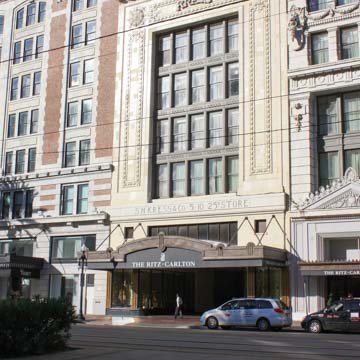The Kress Company rarely employed a non-company architect to design its stores, but because of New Orleans’s distance from New York and the particular circumstances of the site, Kress turned to local architect Emile Weil for its first store in the city. The four upper floors of this five-level building have a continuous vertical screen of sash windows with cast-iron mullions and spandrels set within a decorative terra-cotta frame. The Kress Company authorized the cream-colored terra-cotta facade, a material used only for its most important locations. The facade’s composition and its ornamentation—stylized sunburst and geometric decorations, accented in blue, orange, and green—show the influence of Louis Sullivan. The Kress name is inscribed at the top of the building. A curved metal canopy marks the entrance, which was originally set deep within a long arcade lined with large plate-glass display windows, a characteristic of Kress stores. Inside, a spacious center court was covered by coffered skylights and surrounded by a mezzanine supported on Corinthian columns. The satisfying proportions and ornamentation of the facade more than hold their own next door to the ostentatious Maison Blanche Building (OR84). With the conversion of that building into a hotel, the Kress Building’s ground floor became the hotel’s porte-cochere entrance.
You are here
Kress Building
If SAH Archipedia has been useful to you, please consider supporting it.
SAH Archipedia tells the story of the United States through its buildings, landscapes, and cities. This freely available resource empowers the public with authoritative knowledge that deepens their understanding and appreciation of the built environment. But the Society of Architectural Historians, which created SAH Archipedia with University of Virginia Press, needs your support to maintain the high-caliber research, writing, photography, cartography, editing, design, and programming that make SAH Archipedia a trusted online resource available to all who value the history of place, heritage tourism, and learning.















